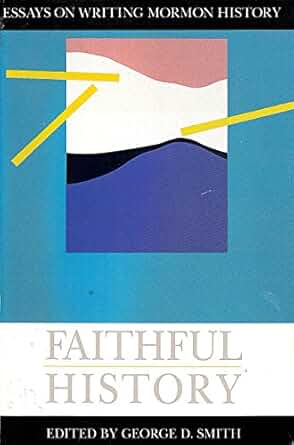Articles/Essays – Volume 25, No. 4
Seeking the Past: Nobel Quest of Fool’s Errand | George D. Smith, ed., Faithful History: Essays on Writing Mormon History
This anthology is designed for people with a professional interest in Mormon historiography as well as for the much larger number of men and women who have been intrigued or alarmed by the rhetoric about “new” and “traditional” Mormon history, about “the intellect” and “the mantle.” The book’s range of authors and titles is impressive. Three contributors are RLDS, three are non-Mormon, and the editor and ten writers range across the spectrum of LDS linkages from Iron Rod to Liahona to once upon a time. All but two selections have had authorized publication before, but all are worth more than one reading. Since the articles are not in precise chronological order, the fol lowing list notes the year in which each first appeared:
Richard L. Bushman, “Faithful History” (1969)
Paul M. Edwards, “The Irony of Mormon History” (1973)
Robert B. Flanders, “Some Reflections on the New Mormon History” (1974)
Richard Sherlock, “The Gospel Beyond Time: Thoughts on the Relation of Faith and Historical Knowledge” (1980)
Edwin A. Gaustad, “History and The ology: The Mormon Connection” (1980)
D. Michael Quinn, “On Being a Mormon Historian (and Its Aftermath)” (new, based on 1981 address)
Lawrence Foster, “New Perspectives on the Mormon Past: Reflections of a Non Mormon Historian” (1982)
C. Robert Mesle, “History, Faith, and Myth” (1982)
Neal W. Kramer, “Looking for God in History” (1983)
Melvin T. Smith, “Faithful History/ Secular Religion” (1984)
Kent E. Robson, “Objectivity and History” (1986)
Martin E. Marty, “Two Integrities: An Address to the Crisis in Mormon Historiography” (1983)
Louis Midgley, “The Acids of Modernity and the Crisis in Mormon Historiography” (1990)
David Earl Bohn, “Unfounded Claims and Impossible Expectations: A Critique of New Mormon History” (1983, 1985, 1990)
Malcolm R. Thorp, “Some Reflections on New Mormon History and the Possibilities of a ‘New’ Traditional History” (1991)
Edward H. Ashment, “Historiography of the Canon” (new)
Leonard J. Arrington, “Epilogue: Myth, Symbol, and Truth” (1985)
The longest and most important essay is Michael Quinn’s (pp. 69-112). It includes his 1981 response to Elder Boyd K. Packer’s “The Mantle Is Far, Far Greater Than the Intellect,” which moved the discussion of the New Mormon His tory into the national media, and traces Quinn’s subsequent professional career, focusing on the circumstances leading to his 1988 resignation from a tenured professorship at BYU. Like all Quinn’s professional writing, the annotation (pp. 96-111) is exhaustive and intriguing.
Richard Bushman’s pioneering article (pp. 1-17) defines “faithful history” in terms not incompatible with most of the New Mormon History that has been writ ten by men and women who have since World War II brought professional credentials and LDS testimonies to the task. Other authors explore with varying emphases and degrees of sympathy the implications, difficulties, and rewards of this combined approach. Smith (pp. 141-54) argues that it cannot be done, and Kramer (pp. 133-40) argues that it should not be undertaken. Midgley (pp. 189-226) and Bohn (227-62) define the New Mormon History as an impossible quest for “objectivity” in writing about the past and assail its practitioners with a sophisticated array of evidence, reasoning, and testimony.
The contributions of non-Mormons Gaustad (pp. 55-68), Foster (pp. 113-22) and Marty (pp. 169-88) merit special attention. A preeminent student of Christian history, Marty addresses the “crisis in Mormon historiography” in terms of “two integrities”—faith and inquiry. His essay, given as a Tanner Lecture to the Mormon History Association, may com fort many who fear that historical study necessarily destroys faith. In an address to a Sunstone Symposium, Gaustad, another expert on the history of Ameri can religions, made these thoughtful observations:
The Mormon view [of time] intensifies the connection between history and theology even more than does the orthodox Christian view. . . . Mormon theology should not be horrified by the notion that dogma has a history, that doctrine develops, and that revelation is not closed. . . . [In 1978] recognition of the relativities of history certainly made easier the modification of doctrine. Clearly Mormonism has a mechanism for change and development in place, (pp. 59, 65)
Ashment’s previously unpublished piece (pp. 281-302) argues that even canonized literature should not be exempt from historical scrutiny, a point made timely by the implications of scriptural inerrancy and prophetic infallibility in some contemporary LDS teaching. None of the articles specifically explores the concept, also found in some contemporary teaching, that LDS historians should present only explicitly faith-promoting information about the Mormon past, a proposition to which no historian, how ever faithful, is likely to give unconditional assent.
Faithful History is attractively printed, and a short introduction by the editor (who is also the president of Signature Books and a contributor in several senses to Mormon history and literature) sets the selections in a larger context. The anthology provides resources (ammunition) for all sides in the current discussion about what Mormon historians should write. It is most likely to be read — and this is unfortunate — by people who agree most strongly with this statement by British historian B. H. Liddell-Hart: “Faith matters so much in times of crisis. One must have gone deep into history before reaching the conviction that truth matters more” (in Edwards, pp. 32-33). This reviewer, like many (friends who have heard Clio’s trumpet, agrees with the sentiment implicit in Arrington’s auto biographical narrative (pp. 303-10): It need not be an “either/or” proposition.
Faithful History: Essays on Writing Mormon History, edited by George D. Smith (Salt Lake City: Signature Books, 1992), 314 pp., $18.95.


 Back to full Issue
Back to full Issue

